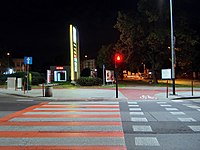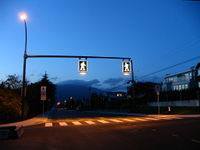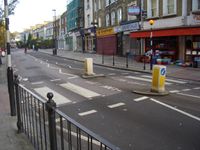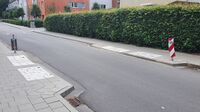Tag:highway=crossing
| Description |
|---|
| The location of a street crossing for pedestrians, cyclists, or equestrians |
| Group: crossings |
| Used on these elements |
| Useful combination |
| Status: de facto |
| Tools for this tag |
|
This tag is for the location of a street crossing for pedestrians, cyclists, or equestrians. In American English, a pedestrian crossing is called a crosswalk if it is marked or signalized. See Crossings for other kinds of crossings.
This tag is only used on nodes. If a crossing is also represented by a way, tag the way with a different highway=* value corresponding to the kind of path that crosses the street, for example highway=footway footway=crossing for a pedestrian crossing.
How to map
To map a street crossing, place a node along the way representing the road, and add the highway=crossing tag to the node.
To describe the type of the transition in more detail, use:
- crossing=*
- crossing=traffic_signals - regulated with light signals
- crossing=uncontrolled (used by JOSM preset) - with crosswalk, without traffic lights
- crossing=marked (used by iD preset) - with crosswalk, with or without traffic lights
- crossing=unmarked - without markings or traffic lights
- crossing:island=yes/no - to tag whether there is an island (former tag
crossing=island) - crossing:markings=* - to tag the existence and style of pedestrian crossing markings
- crossing:signals=* - to tag the existence of pedestrian crossing signals
- crossing:continuous=* - to tag whether the path (footway, cycleway) continues visually uninterrupted across a road
- traffic_calming=table - Use this tag if the section of crossing is raised in comparison to the road it is crossing. Unfortunately, currently no tag is established to mark that it is not raised.
- foot=no - to tag that the crossing is not for pedestrians. Notice that a crossing tagged with foot=no may be crossing a road where pedestrians are allowed. (see also bicycle=no)
- bicycle=yes/no - to tag whether the crossing is also a cycleway crossing used by bicycles. Notice that a crossing tagged with bicycle=no may be crossing a road where cycling is allowed[1]
- horse=yes/no - to tag whether the crossing is also a bridleway crossing used by horse riders.
See the Key:crossing page for additional documentation of this and many other available subtags.
Separately mapped footways
- Main article: Sidewalks#Sidewalk as separate way
In cases where sidewalks are mapped as separate ways it is necessary to also add a crossing way, from one sidewalk through the node shared with the road to the other sidewalk. footway=crossing and cycleway=crossing can be used on ways which lead from a sidewalk to the crossing node (the node which has this highway=crossing tag).
Such split can be also done when footway/cycleway is crossing the road (part where it is crossing may tagged with footway=crossing / cycleway=crossing).
Examples
| Crossing unmarked | Crossing with traffic calming | Crossing near a stop | Crossing with island |
|---|---|---|---|

| |||
|
Adding bicycle=no would be basically pointless, as on other crossings not attached to cycleways or footways where cycling is never allowed (note that the same crossing may benefit from bicycle=no if mapped in place where cyclists can use that sidewalk) |
|
| Crossing with traffic signals | Crossing lit |
|---|---|

|

|
| Crossing & golf cart | Crossing & horse |
|---|---|

|

|
Rendering
- Shows up in OSM2World and in OSM France.
- OpenCycleMap:
 ,
,  bicycle=yes
bicycle=yes - It also is displayed in the JOSM Editor
Routing
Used by OsmAnd, a routing software, to signal and alert.
See also
- railway=crossing - Pedestrians can cross a railway here
- railway=level_crossing - A crossing between a railway and a road
- railway=tram_crossing - A tram crosses the pedestrian way here
- railway=tram_level_crossing - A tram crosses the road here
- railway=railway_crossing - Crossing rails that do not interconnect
- railway=switch - A railway switch
- osm-yolo-crossings - AI import tool for zebra crossings
- Guidelines for pedestrian navigation
References
- ↑ See documentation of bicycle=dismount, see discussions such as for example https://lists.openstreetmap.org/pipermail/tagging/2020-October/thread.html#55611 https://lists.openstreetmap.org/pipermail/tagging/2020-October/thread.html#55632



